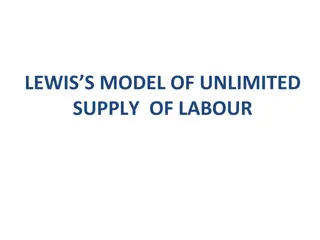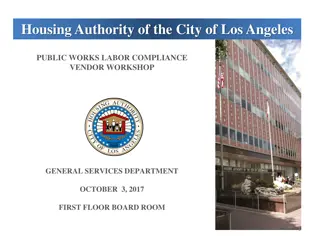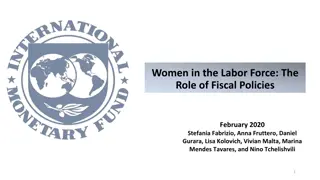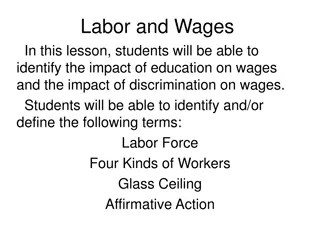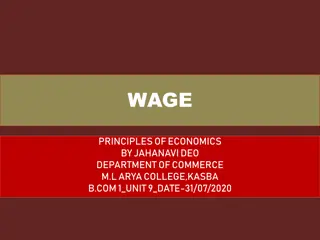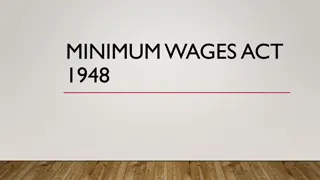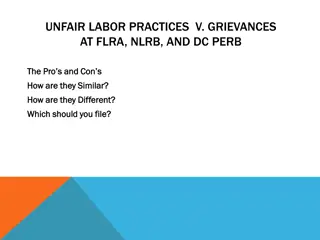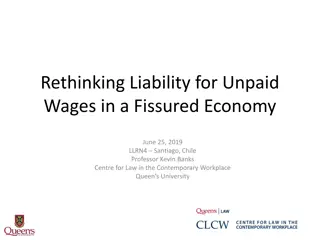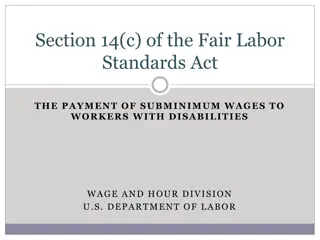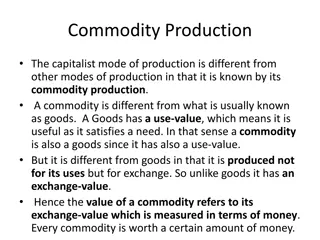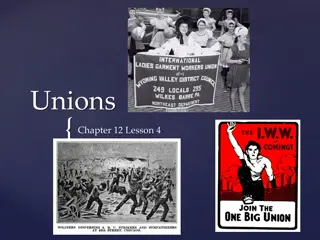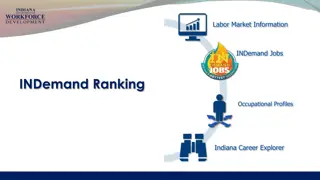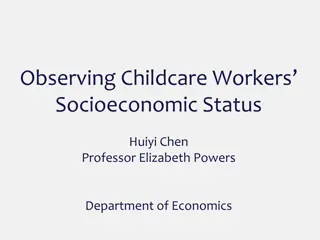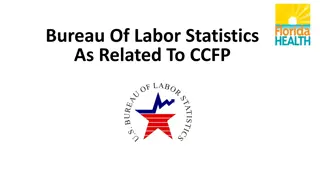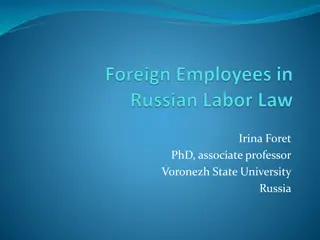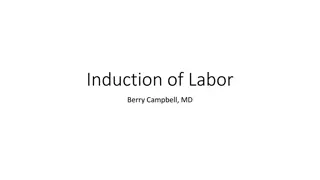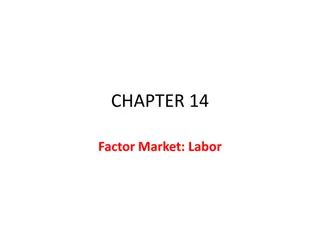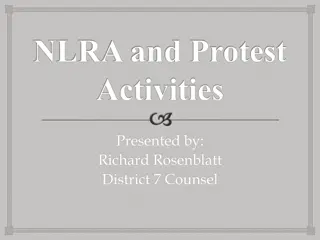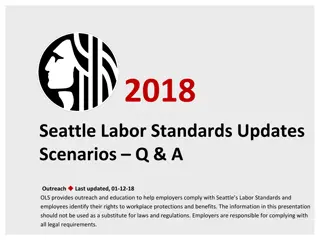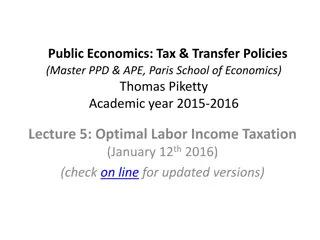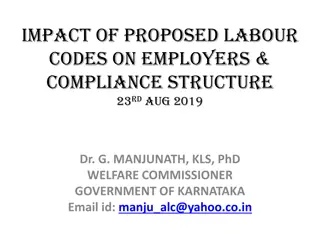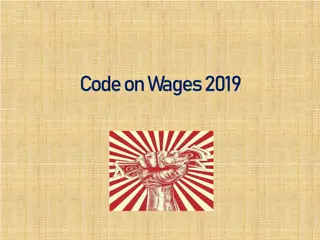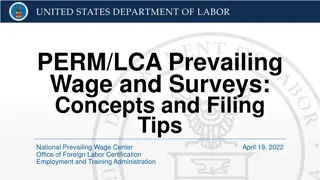Lewis Two-Sector Model: Sustaining Economic Growth Through Labor Transfer
Lewis Two-Sector Model, based on the assumption of surplus labor in agriculture, explains how transferring labor to the industrial sector boosts economic growth. The model highlights the shift from traditional to modern sectors, increased output, wages, and profits, and self-sustaining growth capabi
0 views • 10 slides
Employment and Labor Law in Russia: Overview and Legal Rights for Foreigners
Irina Foret, PhD, an associate professor at Voronezh State University, provides valuable insights into the general issues surrounding employment and labor law in Russia, with a focus on the legal status of foreigners, work permits, and protection of labor rights. The Russian Federation extends right
2 views • 27 slides
Public Works Labor Compliance Vendor Workshop by Housing Authority of the City of Los Angeles
The Housing Authority of the City of Los Angeles conducted a workshop to assist contractors in understanding their Public Works labor compliance responsibilities. The workshop covered topics such as contractor responsibilities, registration with the state under SB854, federal and state labor laws, a
1 views • 26 slides
Gender-Responsive Fiscal Policies and Female Labor Force Participation
Despite persistent gender gaps in labor force participation and wages, various fiscal policy measures have been adopted globally since the mid-1980s to address these disparities. Understanding the impact of gender-responsive fiscal policies on female labor force participation, economic growth, incom
0 views • 23 slides
Understanding Labor and Wages: Education, Discrimination, and Workers
Explore the impact of education on wages and discrimination on income in this lesson. Identify terms like Labor Force, Glass Ceiling, and more. Learn about different types of workers and their skills. Discover how education level affects wages and the distinction between blue-collar and white-collar
1 views • 16 slides
Recent Changes in Labour Laws and Code on Wages, 2019
The recent changes in labour laws involve the amalgamation of 44 laws into 4 codes, focusing on wages, occupational safety, industrial relations, and social security. The Code on Wages, 2019, aims to amend and consolidate laws related to wages and bonus, applicable to all employees in India. The Cod
1 views • 104 slides
Overview of Labor Law and Union Formation Process
Labor law governs the structure and operations of private labor relations in the United States. The National Labor Relations Act (NLRA) establishes the National Labor Relations Board (NLRB) to handle unfair labor practices in the private sector. The process of forming a union involves reaching out t
0 views • 11 slides
Economics of Labor Markets: Factors of Production and Labor Demand
The Economics of Labor Markets explores the markets for factors of production such as labor, land, and capital. Demand for these factors is derived from firms' decisions to produce goods. The labor market, governed by supply and demand forces, exhibits diminishing marginal product of labor due to fi
0 views • 41 slides
Tackling Child Labor in Uganda's Coffee Sector: A Project Approach
The "Child Education Project Uganda" led by Rashida Nakabuga aims to address the root causes of child labor in Uganda, particularly in the coffee sector. With a focus on poverty, gender inequality, and inadequate education, the project adopts a risk-based due diligence approach at the farm level to
0 views • 17 slides
Understanding Wage Principles in Economics
Compensation paid to employees for work is termed as wages and is typically based on an hourly basis. The relationship between real wages and money wages, as well as the concepts of nominal and real wages, are essential in understanding the dynamics of wages in economics.
1 views • 7 slides
Overview of Minimum Wages Act 1948 for Unorganized Workers
The Minimum Wages Act 1948 aims to protect the welfare of unorganized workers by setting minimum wage rates that ensure their subsistence and efficiency. The Act empowers the government to fix minimum wages in industries prone to exploitation. It includes provisions for fixing rates, procedure for r
3 views • 21 slides
Understanding Unfair Labor Practices vs. Grievances at FLRA, NLRB, and DC PERB
Unfair labor practices (ULPs) are violations of federal labor laws, while grievances involve disputes between labor organizations and agencies. Different reviewing authorities handle these matters: FLRA for federal, NLRB for private sector, and DC PERB for DC government agencies. Each organization h
0 views • 47 slides
Challenges of Unpaid Wages in a Fissured Economy
Non-payment of wages, especially in cases of fissuring where subcontracting and dependence on intermediaries are prevalent, poses a significant issue in employment standards legislation. Better enforcement practices are essential, but the complex scenarios of fissuring make compliance challenging. T
0 views • 19 slides
Understanding Section 14(c) of the Fair Labor Standards Act
Section 14(c) of the Fair Labor Standards Act allows for the payment of subminimum wages to workers with disabilities when their productivity is impaired. The Wage and Hour Division of the U.S. Department of Labor oversees compliance with this provision, aiming for a vigorous and effective program.
0 views • 126 slides
Costing and Variance Analysis in Manufacturing Processes
The content discusses various scenarios related to costing and variance analysis in manufacturing processes. It addresses topics such as direct materials usage variance, direct labor mix and yield variances, total direct labor efficiency variance, and standard costing system variances. The examples
0 views • 8 slides
Understanding Product Costs and Prices in Manufacturing
Product costs are expenses incurred to create a product for sale, including direct material, direct labor, and manufacturing overhead. Direct material refers to raw materials used for production, while direct labor includes wages for workers directly involved in manufacturing. Manufacturing overhead
2 views • 7 slides
Understanding Commodity Production and Labor in Capitalist Mode
The capitalist mode of production is characterized by commodity production, where goods are produced not for their use but for exchange. The value of a commodity is determined by its exchange value, measured in money, which is influenced by the quantity of labor involved in its production. Labor, be
0 views • 8 slides
The Rise of Unions and Labor Conditions in the Late 19th Century
Labor conditions in the late 1800s were harsh, with long work weeks, low wages, and no benefits for workers. Deflation caused a rise in the value of money, leading to resentment among workers who organized into unions to demand better wages and working conditions. Craft workers and common laborers f
0 views • 17 slides
Understanding Labor Unions and Collective Agreements in the Workplace
A labor union, also known as a trade union in British English or a labor union in Canadian English, is formed by workers to achieve common goals such as better pay, improved working conditions, and job security. Through collective bargaining, unions negotiate with employers to improve wages, benefit
0 views • 29 slides
Indiana INDemand Jobs and Labor Market Information
Indiana INDemand Jobs are determined based on future demand, percent change, wages, and real-time labor market data. The ranking methodology includes short-term and long-term projections, with a scoring system for each occupation. The Decile Ranking Method assigns scores from 1-10 in various categor
0 views • 14 slides
Examining Socioeconomic Status of Childcare Workers in Illinois
Childcare workers in Illinois earn a median hourly wage of $10.5, ranking 35th in hourly wages among 730 occupations. The study aims to understand the flexibility and demographics of childcare workers compared to other occupations with similar wages. Assumptions suggest childcare work is predominant
0 views • 11 slides
Comprehensive Guide to the Management of Normal Labor by Professor Muhsin-AL-Sabbak
Understanding the management of normal labor is crucial for healthcare professionals. This comprehensive guide covers the definition of normal vaginal delivery, diagnosis of labor, stages of labor, phases of labor, and the use of tools like partogram and cardiotocography to monitor progress. Profess
0 views • 9 slides
Physiology of Labor: Onset and Key Hormonal Changes
Labor, or parturition, involves uterine contractions leading to the fetus's expulsion. Factors triggering labor include hormonal changes like increased estrogen and decreased progesterone, which stimulate uterine muscle activity. Telocytes play a role in spontaneous uterine activity, while oxytocin
0 views • 36 slides
Bureau of Labor Statistics and CCFP Overview
The Bureau of Labor Statistics (BLS) is the key Federal agency responsible for measuring labor market activity, working conditions, and price changes. Their data includes employment cost trends, wages by area and occupation, and regulations like FNS 796-2 REV.4. BLS provides essential economic infor
0 views • 10 slides
Migration Policies and Labor Laws in Russia: A Comprehensive Overview
Irina Foret, PhD, an associate professor at Voronezh State University, delves into the legal status of foreigners in Russia, including work visas, labor rights violations, and legal remedies. Key aspects such as Article 62 of the Constitution and Article 11 of the Labor Code are discussed, highlight
0 views • 30 slides
Impacts of Labor Productivity by Age and Changes in Age Structure on Labor Productivity in Vietnam
This research focuses on quantifying the impact of labor productivity by age on the overall economy's labor productivity in Vietnam. Utilizing analytical methods like the Cobb-Douglas production function and Shift-Share Analysis, the study aims to understand how changes in age structure and labor sh
0 views • 26 slides
Induction of Labor: Methods and Considerations
Induction of labor is done to achieve vaginal delivery before spontaneous onset, usually at 39 weeks or when medically necessary. Risks include failed induction, cesarean section, uterine rupture, prolonged labor, and infections. Cervical ripening methods help prepare the cervix for labor. The Bisho
0 views • 18 slides
Understanding Competitive Factor Market in Labor Economics
A competitive factor market involves a large number of sellers and buyers of a factor of production, like labor. With no single entity influencing prices, each acts as a price taker. The demand for factors depends on firms' output levels and input costs, leading to derived demands. Profitability of
0 views • 43 slides
Economic Disparities in the European Union: Insights from 2018 Meetings
The data presented showcases wage inequalities, compensation rates, minimum wages, monthly salaries, and low-paid workers' share in the EU, particularly focusing on Bulgaria. The figures indicate disparities among EU countries in terms of hourly wages, minimum wage levels, average monthly salaries,
0 views • 11 slides
Understanding W-2 Discrepancies and Pay Statement Variances
The W-2 form and pay statements may not always match due to differences in taxable wages, deductions, and withholdings. Understanding how to reconcile Box 1 wages, Box 2 federal income tax withheld, and Box 3 Social Security wages can help employees accurately report their income for tax purposes. T
0 views • 14 slides
Understanding NLRA and Protest Activities Led by Richard Rosenblatt
Protected concerted activities lie at the core of Section 7, with specific focus on wages, hours, and working conditions. Recognizing strikes as a form of protected concerted activity is essential, distinguished by whether they pertain to unfair labor practices or economic reasons. The significance
0 views • 22 slides
Understanding Labor Productivity Growth in Europe: Insights from Productivity Project Conference
Divergent experiences in labor productivity growth between the US and Europe have sparked interest in analyzing factors affecting productivity. The Productivity Project Conference in January 2015 delved into macro and micro-level determinants of labor productivity, focusing on Total Factor Productiv
1 views • 27 slides
Department of Employment and Labour: Vision, Mandate, and Objectives
The Department of Employment and Labour aims to regulate the labor market through policies focusing on economic efficiency, decent employment, labor standards, and social safety nets. The department's vision is to create a conducive labor market for investment, economic growth, employment, and decen
0 views • 35 slides
Understanding Labor and Delivery: An In-depth Guide
Labor and delivery involve several stages and assessments to ensure the well-being of both the mother and the baby. From recognizing the signs of true labor to understanding the stages of labor, pain management options, and interventions such as active management of the third stage, this comprehensi
0 views • 11 slides
Understanding Abnormal Labor and Prolonged Labor in Childbirth
Labor is considered abnormal when there is poor progress or signs of compromise in the fetus. Prolonged labor, lasting more than 18 hours, may result from various factors affecting cervical dilatation and descent of the presenting part. Causes include issues with power, passage, and passenger. Diagn
0 views • 20 slides
Seattle Labor Standards Updates and FAQs 2018
Outreach OLS provides guidance on Seattle Labor Standards for employers and employees. Learn about minimum wages, PSST, and employee rights. Get answers on legal wage rates, PSST coverage, and accrued hours limits. Stay informed to ensure compliance with labor regulations.
0 views • 32 slides
Optimal Labor Income Taxation: Main Theoretical Results and Intuitions
The optimal taxation of labor income involves a U-shaped pattern of marginal tax rates, with top rates influenced by income concentration and labor supply elasticities. Mirrlees' model analyzes optimal labor income taxes based on productivity and labor supply decisions, aiming to maximize social wel
0 views • 24 slides
Impact of Proposed Labour Codes on Employers and Compliance Structure
This content discusses the impact and evolving compliance structure under the Code on Wages, 2019, focusing on clauses related to minimum wages, payment of wages, and payment of bonus. It outlines key aspects like wage fixation, deductions from wages, eligibility for bonus, and computation of profit
0 views • 23 slides
Evolution of the Code on Wages: A Comprehensive Overview
The Code on Wages, 2019 aims to streamline and modernize labor laws in India by consolidating various regulations into four codes. The journey of this code, from its inception to becoming law, is detailed along with the significance of the proposed changes. The evolution of labor laws and the implic
0 views • 17 slides
United States Department of Labor Prevailing Wage and Surveys Overview
Explore the concepts and filing tips related to prevailing wages and surveys by the United States Department of Labor. The presentation covers general filing tips, validity periods, wage survey concepts, and more provided by key presenters from the National Prevailing Wage Center. It emphasizes the
0 views • 55 slides
